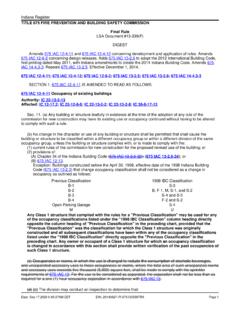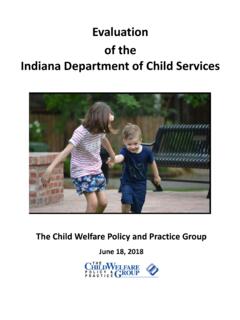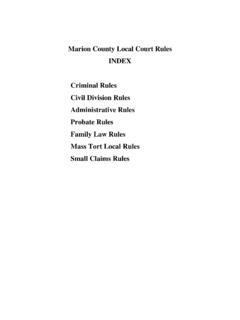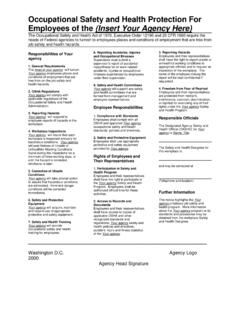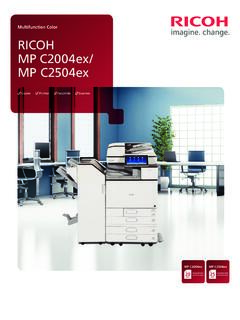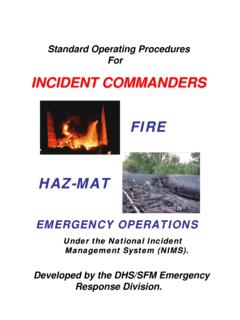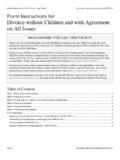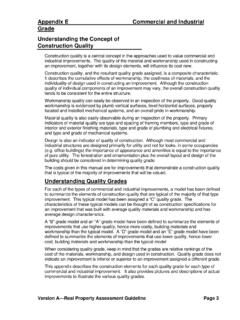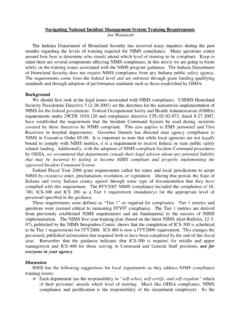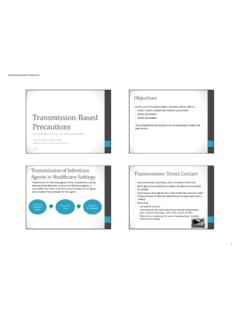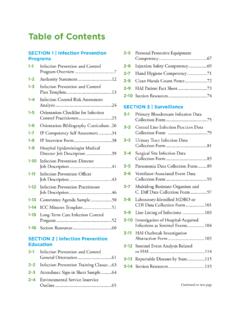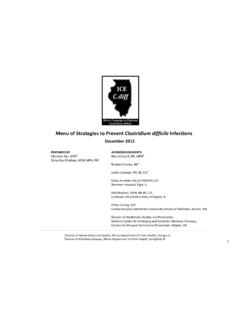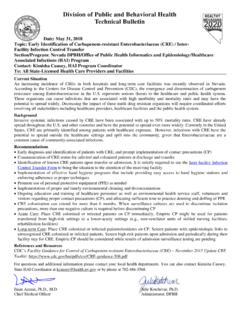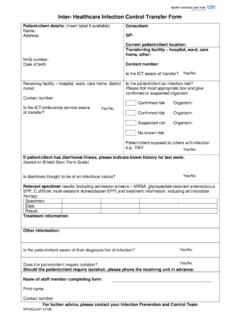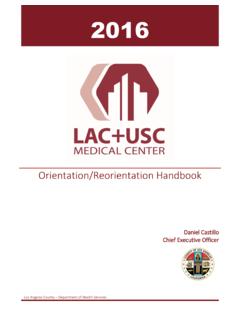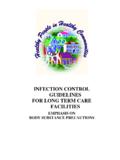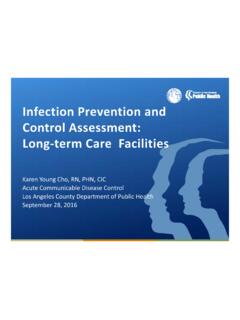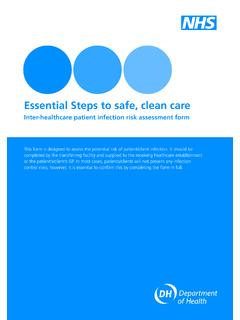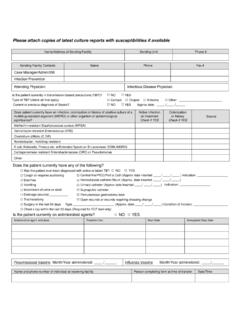Transcription of Understanding What Your Infection Prevention Program ...
1 Version Understanding What Your Infection Prevention Program Should Look Like Long Term Care Setting Table of Contents 1. What Your Infection Prevention Program Should Look Like .. Page 3 2. Historic Basis for Use of Evidence-based Policies and Procedures .. Page 4 3. inter - facility Infection control Transfer Form .. Page 5 4. Disclaimer of Endorsement .. Page 7 5. Foley Catheter Care and Maintenance Patient Education Guide .. Page 8 6. Reportable Communicable Diseases and Conditions .. Page 20 7. Communicable Disease Report Form.
2 Page 22 8. How to Handwash? .. Page 24 9. How to Handrub? .. Page 25 10. Your 5 Moments for Hand Hygiene .. Page 26 11. Estimating Hand Hygiene Opportunities Worksheet .. Page 27 12. Hand Hygiene Observation Tool .. Page 28 13. Sequence for Putting on Personal Protective Equipment .. Page 29 14. Help Protect Our Patients Poster .. Page 32 15. Cover Your Cough Poster .. Page 33 16. The Core Elements of Antibiotic Stewardship for Nursing Homes .. Page 34 17. 2016 APIC Position Paper: Safe Injection Practices .. Page 55 18. Assessment of Current CDI Prevention Activities.
3 Page 73 19. EPA s Registered Antimicrobial Products Effective against Clostridium difficile .. Page 75 20. Long Term Care Infection Prevention Program Checklist .. Page 76 21. CMS F441 Infection control Long Term Care Guidelines .. Page 79 22. Indiana Rule 410 IAC Infection control Program .. Page 81 WHAT YOUR Infection Prevention Program SHOULD LOOK LIKE I. Infection control Program and Infrastructure II. Healthcare Personnel and Resident Safety III. Surveillance and Disease Reporting IV. Hand Hygiene V. Personal Protective Equipment (PPE) VI.
4 Respiratory/Cough Etiquette VII. Antibiotic Stewardship VIII. Injection Safety and Point of Care Testing IX. Environmental Cleaning X. Guidelines: a. CMS F441 b. ISDH 410 IAC 1-18 This manual/document is not a complete tool of all best practices and requirements, but is intended as a resource tool that can be used to improve your Infection control Program . You must also meet the requirement of the Centers for Medicare and Medicaid Services (CMS) and the Indiana State Department of Health (ISDH) as found in Federal and state laws and regulations.
5 Historic Basis for Use of Evidence-based Policies and Procedures in Infection Prevention to Prevent Healthcare Associated infections In 1974 the Centers for Disease control (CDC) undertook the first nationwide study to evaluate approaches to prevent healthcare associated infections (HAIs). As a result of that initial study many professionals, organizations, and agencies have worked collaboratively over the years to decrease the risk and potential negative outcomes associated with HAIs affecting persons receiving care within our nation s healthcare systems.
6 Scientific studies, Infection Prevention strategies, legislation, and dedicated individuals have been successful in reducing HAIs dramatically where adoption of evidence-based methods have been implemented. The study results can be found at the CDC s web site ( ), in scientific journals, from professional associations dedicated to the Prevention of HAIs in their published position papers, recommendations and guidelines. The Indiana State Department of Health is making resources available for healthcare facilities within our state with the same goal in mind; reduce HAIs in healthcare settings using evidence-based methods which provide a safer healthcare environment.
7 Individuals in the role of Infection Prevention are encouraged to affiliate themselves with these professional associations, so that they can base their Program development on these evidence-based recommendations. The following pages have been developed to provide a guide with the fundamental goal of reducing HAIs in all healthcare settings. inter - facility Infection control TRANSFER FORM This inter - facility Infection control patient transfer form can assist in fostering communication during transitions of care for patients colonized or infected with a multidrug-resistant organism.
8 Discharging facility should complete this transfer form and sign at the bottom after all fields are completed. Attach copy of records and latest laboratory reports with susceptibilities going with patient to receiving facility . me m g Firsi t Name Birth: MRN: ee Date: D DD D D D D D D DD D D D D DD D D D DD DD DD DD Infection control TRANSFER FORM (Discharging facility to complete form and communicate information to Receiving facility ) Demographics Patient/Resident Last Name Date of Birth: MRN: Sending Faacility Name: Contact Name: Contact Phhone: Receiving facility Namme: Precautions Currently in Isolationn Precautionns?
9 If Yes checck: Contact Droplet Yes Airborne No Isoolation Precautions Organisms Did or doees have (send documeentation): Current Infectionn, History, or Ruling OOut* No Knowwn MDRO or Commmunicable Disseases Multiple Drrug Resistannt Organism (MDRO): Yes MRRSA VRE Acinetobacter noot susceptiblee to carbapenems Carbapenemase-producing CRE (CP-CRE) C. ddifficile Other : _____ , lice, scabies, disseminated shingles, norovirus, flu, TB, etc. *Additional info if knowwn: Symptoms Check yess to any thaat currently apply*): Cough/uuncontrolled rrespiratory seecretions Acute diarrrhea or inconttinent of stooll Incontinnent of urine Draining wounds Vomiting Other uncoontained body fluid/drainagge Concerning rash (.
10 Vvesicular) *NOTE: Apppropriate PPPE required ONLY if incoontinent/draiinage/rash NNOT containeed No Sympptoms or PPPE not requuired as contained ANY YES: Answers to ssections abovve Check Reqquired PPE ALL NO: Juust sign form Persson completi ng form: Rolee: DDate: / / Required PPE Discharge Date: First Name Other: _____ Disclaimer of Endorsement: The following Foley Catheter Care & Maintenance Patient Education Guide is intended for educational purposes only. The Indiana State Department of Health does not endorse or recommend any specific manufacturer.
